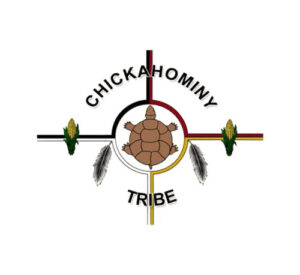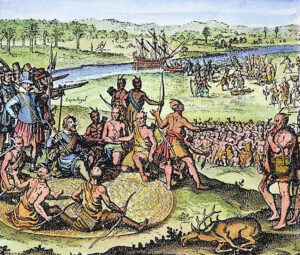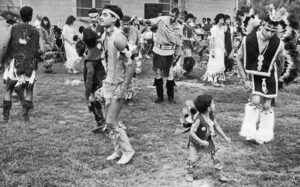The Chickahominy people are a tribe of the Powhatan Confederacy who formerly lived in permanent villages on the Chickahominy River in Virginia. The Chickahominy, meaning “The Coarse Ground Corn People,” were among numerous independent Algonquian-speaking tribes who had long occupied the Tidewater area near Jamestown, Virginia. Algonquin lands once stretched all the way from the southeastern coastal plain to near the Arctic Circle. Like other Algonquins in the area, the Chickahominy are often called Powhatan Indians. However, their villages were always independent and never under the control of Chief Powhatan. Rather than being ruled by a single chief, they governed themselves through a council of elders.
Today, the Chickahominy Tribe is a state and federally-recognized Indian tribe located on 110 acres in Charles City County, midway between Richmond and Williamsburg, Virginia.
Tribe members encountered settlers from the first permanent English settlement founded at Jamestown in 1607. They traded with John Smith on his several voyages up the Chickahominy River in 1607 and taught the colonists how to grow and preserve their own food.
In 1613, they allied with the English and assumed the name Tassautessus or “Englishmen.”
After the First Anglo-Powhatan War from 1609 to 1614, the Chickahominy Indians negotiated an independent treaty with the colonists, becoming tributary allies of the Virginia colonists, providing 300 bowmen in case of war with the Spanish and paying a yearly tribute of two bushels of corn for every fighting man.
Over time, the English began to expand their settlements and crowded out the Chickahominy from their homeland. The people had earlier come into conflict over land uses, as the Chickahominy expected to travel freely for hunting, and the English wanted to preserve some property as private.
While independent, the Chickahominy were sometimes allied in the 17th century with Chief Powhatan and his paramount chiefdom, a confederacy of 30 or so Algonquian-speaking tribes. They may have served in a “police” role, used by Powhatan to quell rivalries and end infighting amongst other confederacy tribes. In return, they enjoyed some benefits, such as trading with the confederacy tribes. As part of the alliance between Powhatan’s confederacy and the Chickahominy, it appears they were to act as a buffer “warrior force” between the confederacy tribes and other less friendly or hostile tribes in the event of an attack, thus giving Powhatan’s forces time to mobilize.
In 1644, the Chickahominy joined the paramount chief, Opechancanough, in his attacks against the English. The peace treaty concluding that war in1646 set aside land for Virginia Indians, including the Chickahominy, in the Pamunkey Neck area of present-day King William County.
Following the Anglo-Powhatan Wars of 1644-46, the tribe, a treaty, displaced the Chickahominy people from this area and set aside land for them in the Pamunkey Neck area of Virginia alongside another Virginia Algonquian tribe, the Pamunkey, between the Mattaponi and Pamunkey Rivers. As the settlers prospered, they crowded the Chickahominy Tribe out of this area as well.
In 1661, they moved again to the Mattaponi headwaters, but the expanding English colony continued encroaching upon their reserved holdings. In 1677, the Chickahominy were among the tribes signing a peace treaty with the King of England.
In 1669, they were estimated at a little over 200 people, but by 1722, they were reported to number only about 80.
In 1677, the Pamunkey chief Cockacoeske signed a new treaty with the English on behalf of several Indian groups. Still, the Chickahominy, joined by the Rappahannock, refused to become subservient to her or pay her tribute. After 1718, the Indians were forced to relocate, and by 1820, the Chickahominy Indians had gradually begun to settle in the tribe’s present-day location on Chickahominy Ridge. There, they purchased land, built homes, and established the Samaria Indian Church.
The people lost the title to the last part of their reservation lands in 1718 but continued to live in the area for some time. Those who did not merge with the Pamunkey and other tribes slowly migrated back to New Kent County and Charles City County, closer to their original homeland. In the 20th century, descendants of these people organized to form the current Eastern Chickahominy and Chickahominy tribes, respectively. The migrations happened before the end of the 18th century, and few records survive in this “burnt-over district,” disrupted by major wars, by which to establish their migration dates.
The 20th century was a time of great change for the Chickahominy people. Under the Racial Integrity Act, Virginia’s policies of segregation were among the most severe in the nation. Officials went so far as to destroy documents and records of Native people — including birth, marriage, census, and death records. According to state policy, Virginia’s Native peoples no longer existed.
The Chickahominy tribe reorganized early in the 1900s. In 1901, the Chickahominy Tribe established the Samaria Indian Baptist Church, which remains an important focal point for the community today.
Higher education was unavailable for Indians in Virginia until the 1960s, so the tribal members built schools and raised funds to pay teachers’ salaries. However, even then, state law barred the children from receiving a diploma in Virginia, so many of them went to Oklahoma to complete high school and attend college.
The people of the Chickahominy Tribe Eastern Division shared history with the Chickahominy until 1983 when they decided to organize their own tribal government. As their community was based in New Kent County, some found traveling to Charles City County inconvenient for tribal meetings. Others said the split happened because of religious practice and land use disagreements. However, family ties kept the two tribes intertwined.
The Commonwealth of Virginia recognized the Chickahominy in 1983 as they continued to seek Federal recognition.
In the early 21st century, the Chickahominy tribe consisted of about 840 people who lived in an area known as Chickahominy Ridge. Several hundred more lived in other parts of the United States, including California, Florida, New York, Oklahoma, South Carolina, West Virginia, and Pennsylvania.
The Chickahominy Tribe was federally recognized on January 11, 2018. This recognition also granted federal recognition to the Eastern Chickahominy, the Upper Mattaponi, the Rappahannock, the Monacan, and the Nansemond. These tribes had been seeking federal recognition through an act of Congress since the 1990s.
Today, most Chickahominy families continue to live in the Chickahominy Ridge area between Richmond and Williamsburg. It is only a few miles from one of their 1607 village sites. A Tribal Council of 12 men and women, including a chief and two assistant chiefs, are elected by vote of the tribe.
Over 850 people are enrolled in the Chickahominy Tribe, most of whom still live within five miles of the tribal center. About 110 acres of current tribal lands are in the tribe’s traditional territory, present-day Charles City County. The tribal center on the land is the location of an annual Powwow and Fall Festival.
Most members of the Chickahominy Tribe are Christian; many attend Samaria Baptist Church, formerly called Samaria Indian Church, in Charles City County. The church was built upon tribal grounds and once served as a school for the tribe’s children. It is located directly across from the tribal headquarters.
Today, the Eastern Chickahominy has about 132 members and owns about 41 acres of land. The tribe serves the needs of its community as a nontaxable organization supported by contributions from members who pay dues. It is based in New Kent County, about 25 miles east of Richmond.
©Kathy Alexander/Legends of America, updated March 2024
Also See:
Native American Photo Galleries
Native Americans – First Owners of America
Sources:



